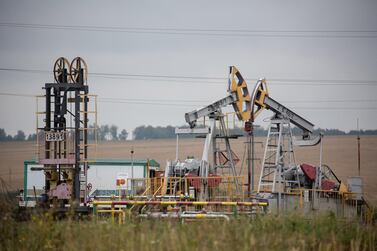Oil prices surged to a five-month high on Wednesday as powerful storms shut operations along the US Gulf Coast.
Brent, the benchmark for two-thirds of global oil trade, was up 0.48 per cent at $46.08 per barrel at 11.36am UAE time, while West Texas Intermediate, which tracks US crude grades, was up 0.12 per cent at $43.40 per barrel.
Oil rallied as hurricane Laura was set to become a category 1 storm while making landfall on the US Gulf coast. Around 1 million barrels per day of oil and 1.2 billion cubic feet of gas per day from the Gulf of Mexico have been shut-in as another hurricane, Marco, approaches the coastline.
US inventories also continued to decline, adding to further tightening of supply. The industry-funded American Petroleum Institute on Tuesday reported stocks fell by 4.52 million barrels last week, while gasoline inventories declined by 6.39 million barrels, marking a fifth weekly decline.
“Our latest expectation for the combined impact on supply of Hurricane Laura and Post-Tropical Cyclone Marco is for some 1.65m bpd of crude production to be offline during peak impact around 26 August, just after Laura makes landfall,” JBC said in a note on Wednesday.
A storm surge is likely to have a “transient” effect on operations along the US Gulf Coast, Robin Mills, chief executive at Qamar Energy, told a webinar organised by Gulf Intelligence on Wednesday.
“[It] doesn’t seem that any major damage has been done in the storms blowing through and platforms evacuating but I presume they'll all be up and operating fairly soon,” he said.
World oil demand, which has slumped this year as movement restrictions were put in place to stem the spread of Covid-19, is expected to revive close to pre-virus levels by the end of the first quarter of next year, according to IHS Markit.
Global oil demand is currently at 89 per cent of the levels before the virus spread, but is expected to increase to 92-95 per cent by March next year, the consultancy said.
Oil demand dropped severely in the first half of this year, but as restrictions eased it has recovered by 13m bpd over the last four months. However, it is likely to remain below pre-virus levels as air travel and commutes to work will be subdued until vaccines are widely available, IHS Markit said.
Flight numbers are still about 30 per cent lower than the levels seen in February, with fuel consumption about 50 per cent lower thank the same period last year, due to the slower recovery of long-haul journeys.
Although demand is only recovering gradually, the consultancy does not expect a return to the huge supply overhang that took place in April between the expiry of one Opec+ deal and the agreement of another, with producers ramping up output in between.
“Opec+ members have rediscovered production restraint since then and US output is expected to be lower as well. That means that markets can continue to rebalance, even if a full return to pre-Covid demand levels is put off for the time being,” said Jim Burkhard, vice president and head of oil markets at IHS Markit.
The Opec+ alliance is drawing back 7.7m bpd from the markets and is expected to convene its next joint ministerial monitoring committee on September 17 to review compliance.








